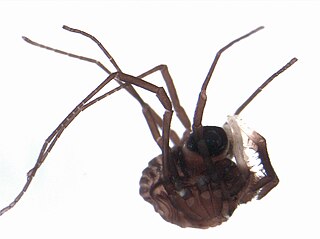
Arachnida is a class of joint-legged arthropods, in the subphylum Chelicerata. Arachnida includes, among others, spiders, scorpions, ticks, mites, pseudoscorpions, harvestmen, camel spiders, whip spiders and vinegaroons.

The Opiliones are an order of arachnids colloquially known as harvestmen, harvesters, harvest spiders, or daddy longlegs. As of April 2017, over 6,650 species of harvestmen have been discovered worldwide, although the total number of extant species may exceed 10,000. The order Opiliones includes five suborders: Cyphophthalmi, Eupnoi, Dyspnoi, Laniatores, and Tetrophthalmi, which were named in 2014.

A carapace is a dorsal (upper) section of the exoskeleton or shell in a number of animal groups, including arthropods, such as crustaceans and arachnids, as well as vertebrates, such as turtles and tortoises. In turtles and tortoises, the underside is called the plastron.

Laniatores is the largest suborder of the arachnid order Opiliones with over 4,200 described species worldwide. The majority of the species are highly dependent on humid environments and usually correlated with tropical and temperate forest habitats.

Cosmetidae is a family of harvestmen in the suborder Laniatores. With over 700 species, it is one of the largest families in Opiliones. They are endemic of the New World with a Nearctic-Neotropical distribution where a large fraction of the diversity of Opiliones are represented by this single family. Cosmetidae have the northern extent of their range into the USA, where a small number species occur in the southern states. However, the family is especially diverse in Mexico, Central America and northern South America; especially the Andean realms. Their range also extends further south into Argentina and southern Brazil, but they are absent in Chile. Cosmetidae are prevalent in Amazonian region, but only relatively few also occur in Brazilian Atlantic Forest. Several species are also found in the Caribbean.

Dyspnoi is a suborder of harvestmen, currently comprising 43 extant genera and 356 extant species, although more species are expected to be described in the future. The eight families are currently grouped into three superfamilies: the Acropsopilionoidea, Ischyropsalidioidea, and Troguloidea.

The Sironidae are a family of harvestmen with more than 60 described species.

Caddoidea superfamily of harvestmen arachnids with a single family Caddidae, which now only contains 2 extant species. The family previously contained many more taxa under a previous wider concept, but the familial definition was narrowed after restudy.

The Cranaidae are a family of neotropical harvestmen within the suborder Laniatores.
The Zalmoxidae are a family of harvestmen within the suborder Laniatores.
The Synthetonychiidae are a small family of harvestman with a handful of species in a single genus. They are endemic to New Zealand.
Yania is a genus of harvestmen from South America. Yania flavolimbata is the only species in the monotypic genus Yania. It was first described by Roewer, 1914.

Siro is a genus of mite harvestmen in the family Sironidae with 7 described species. All are found in Europe.

Caddo is a genus of harvestmen in the family Caddidae. There are two described species in Caddo. Both species are found in North America and Eastern Asia.
Arhesiro clousi is a species of mite harvestman in the family Sironidae.. It is found in North America, specifically USA, Oregon, Lincoln County.
Neosiro boyerae is a species of mite harvestman in the family Sironidae. It is found in North America, specifically USA, Oregon, Lincoln County.
Arhesiro sonoma is a species of mite harvestman in the family Sironidae. It is found in North America, specifically USA, California, Sonoma County.
Holosiro calaveras is a species of mite harvestman in the family Sironidae. It is found in North America, specifically California in Calaveras county.
Parasiro is a genus of harvestmen belonging to the family Parasironidae with one described species. It is found in Southwestern Europe.
Insidiatores is an infraorder of opilions in the suborder Laniatores. It includes over 500 species distributed mainly in temperate latitudes.








